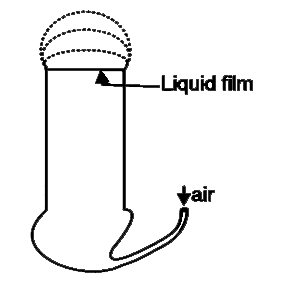A glass tube of radius R is covered with a liquid film at its one end. Air is blown slowly into the tube to gradually increase the pressure inside. What is the maximum pressure that the air inside the tube can have? Assume that the liquid film does not leave the surface (whatever its size) and it does not get punctured. Surface tension of the liquid is T and atmospheric pressure is .

The correct Answer is:
Step by step video, text & image solution for A glass tube of radius R is covered with a liquid film at its one end. Air is blown slowly into the tube to gradually increase the pressure inside. What is the maximum pressure that the air inside the tube can have? Assume that the liquid film does not leave the surface (whatever its size) and it does not get punctured. Surface tension of the liquid is T and atmospheric pressure is P_(o). by Physics experts to help you in doubts & scoring excellent marks in Class 11 exams.
Topper's Solved these Questions
Similar Questions
Knowledge Check
- Question 1 - Select One
Pressure at a point inside a liquid does not depend on
Adensity of the liquid.Bheight of the liquid column above the point.Caccele.ration due to gravity.Dbase area of the container. - Question 2 - Select One
A liquid film at the surface behaves as a
Astretched membraneBunstretched membraneCexpanding surfaceDunoccupied space. - Question 3 - Select One
Pressure at a point inside a liquid does not depend on
Athe depth of the point below the surface of the liquidBthe nature of the liquid .Cthe acceleration due to gravity at that point .Dthe shape of the vessel containing liquid .
Pressure at a point inside a liquid does not depend on
View SolutionPressure at a point inside a liquid does not depend on
View SolutionPressure at a point inside a liquid does not depend on
View SolutionIf a liquid does not wet the material of a capillary tube, then the liquid in it
View SolutionPressure at a point inside a liquid does not depend on:
View Solution
